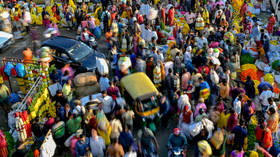Population of India to peak at 1.7bn before decline – UN

The population of India, the most populous country in the world, is set to reach a peak of 1.7 billion in the 2060s before it will start declining, a new United Nations (UN) report has predicted. At present, the South Asian country has a population of around 1.4 billion.
According to the World Population Prospects 2024 report, after reaching the peak, the Indian population is set to dip by around 12% by 2100. However, the country is likely to remain the most populous nation in the world throughout the century, according to the report.
India last year overtook China to become the most populous country. The UN expects that China’s population has peaked and is declining. “This is because of a rapid drop in China’s fertility rates, which have been below the “replacement rate” – the average number of children per woman needed to keep the population constant from one generation to the next — for a long time,” according to the research.
India and China will be followed in the population rankings in 2100 by Pakistan (511 million), Nigeria (477 million), Democratic Republic of the Congo (431 million), and the US (421 million), according to the report. The increase in the US population, the report noted, will be primarily driven by migration.
India is expected to contribute 30% of the wealth that will be created globally in the next 25 to 50 years, Ashish Chauhan, CEO of the country’s National Stock Exchange, one of its two main exchanges, suggested during RT’s ‘Let’s Talk Bharat’ show earlier this year, adding that tech-savvy young people would be at the forefront of the process.
Previous research suggests that India is home to around 600 million young people between 18 and 35, and that nearly 69% of its population will be of working age by 2030, which will result in the dependency rate plummeting.
Meanwhile, government data shows that 31 out of 36 states and Union Territories in the country have achieved the replacement-level fertility rate of 2.1, after seven decades of family-assistance measures. Exceptions include Bihar and Uttar Pradesh, two of the most densely populated and economically disadvantaged states.
Around 56% of the population has adopted modern contraceptives to control births, New Delhi announced earlier this week.













